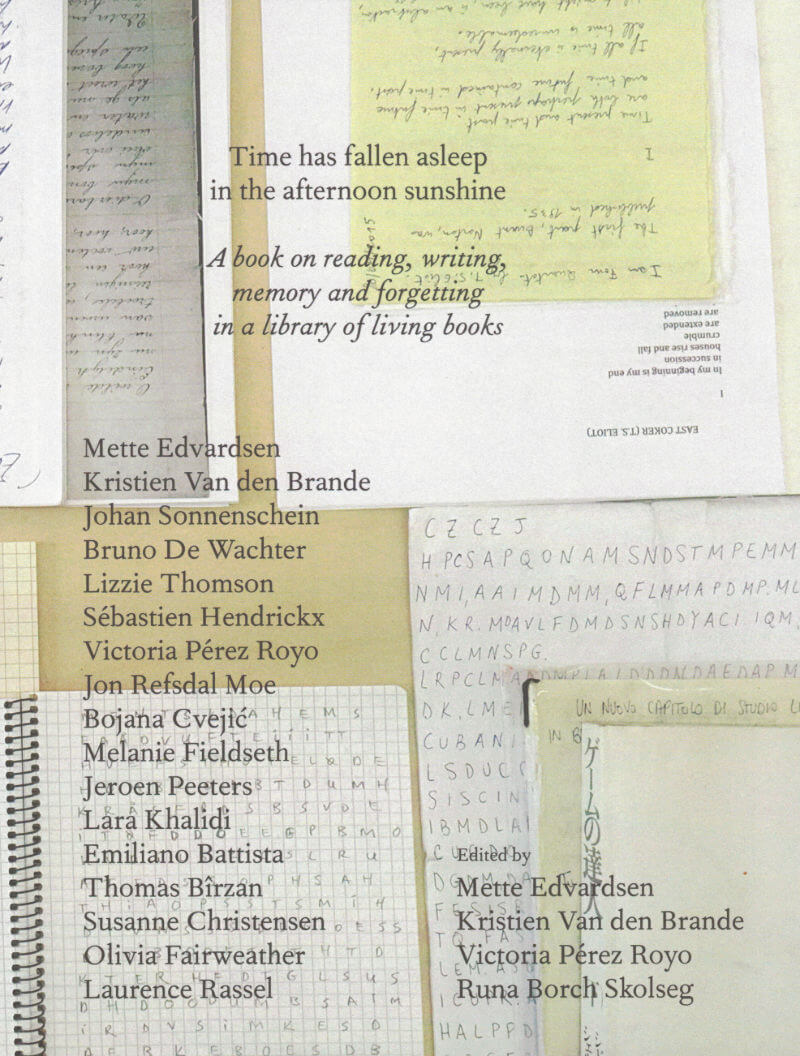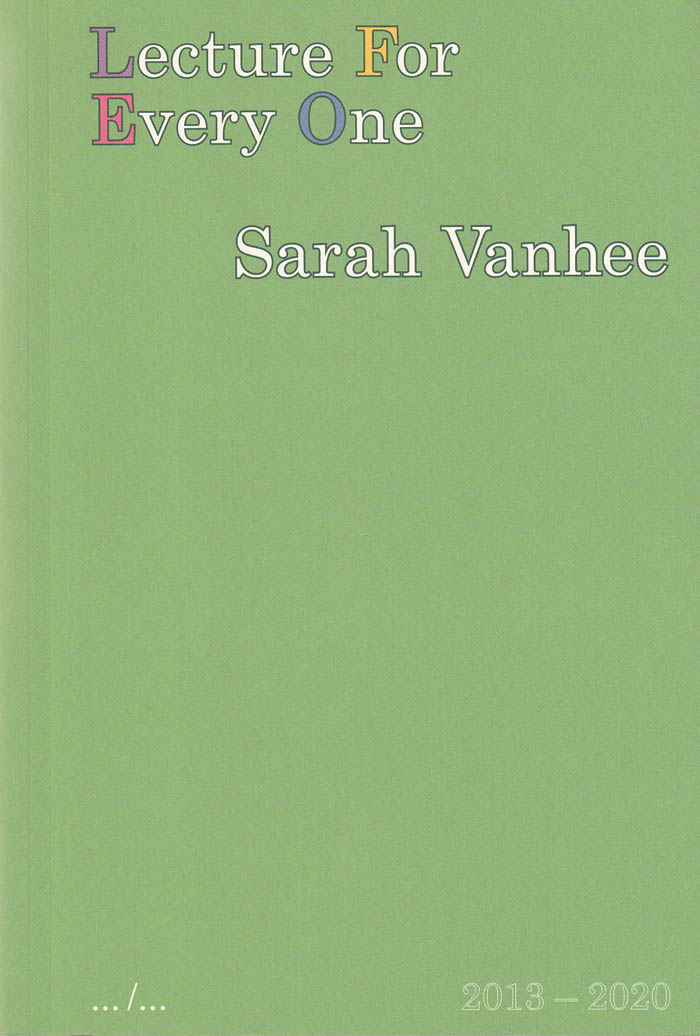Kristien Van den Brande
Kristien Van den Brande

Time has fallen asleep in the afternoon sunshine
Runa Borch Skolseg, Victoria Pérez Royo and 2 more
A book on reading, writing, memory and forgetting in a library of living books.
This publication documents a project inspired by Bradbury's Fahrenheit 451, in which performers memorize a book to form a collection of living books to be read in libraries by visitors. The publication brings together eighteen text contributions from artists and theoreticians, and a visual essay.
The project Time has fallen asleep in the afternoon sunshine starts as a group of people who dedicate themselves to memorizing a book of their choice. Together they form a library collection consisting of living books. The “books” pass their time in libraries reading, memorizing, talking to each other, going for walks outside, prepared to be read by a visitor. The readings take place as intimate one-to-one encounters where the “book” recites its content to the reader. Over time the project grew into a library collection of more than eighty living books in twelve different languages across Europe and beyond. The project developed into a bookshop, a publishing house and an exhibition format, and hosted workshops, lectures and talks and, eventually, a book.
The publication brings together eighteen text contributions from artists and theoreticians with a varying degree of proximity to the project. Their reflections touch on memory and forgetting; on the practice of learning by heart and its corporeality; on reading, re-reading, reading aloud, reading for oneself and for others; on writing, re-writing and translating; on invisible and impossible literatures; on alternative temporalities and their respective economies; on archives, libraries, bodies and other sites for conservation; on the problems of authorship and originality; on immateriality and its discontents; on the equivocal borders between reality and fiction; and on the strange and unforeseeable dynamics of people and stories coming together, disseminating and unexpectedly crossing paths again. The second part of the book is a visual essay that documents the processes of memorizing, reading and re-writing.
Contributions by: Mette Edvardsen, Kristien Van Den Brande, Johan Sonnenschein, Bruno De Wachter, Lizzie Thompson, Sébastien Hendrickx, Victoria Pérez Royo, Jon Refsdal Moe, Bojana Cvejić, Melanie Fieldseth, Jeroen Peeters, Lara Khalidi, Emiliano Battista, Thomaz Bîrzan, Susanne Christensen, Olivia Fairweather and Laurence Rassel.
And more

F.R. David - "Erratum"
Following an open call, this is—the very last issue—a collectively-compiled "Erratum", or addendum [if you will] to the twenty-three issues from 2007 until now.
Edited with Paul Abbott, After 8, Alma Sarif, Phil Baber, Daniel Blumberg, Thomas Boutoux, Kristien Van den Brande, Chloe Chignell, Martina Copley, Anthony Elms, Chris Evans, Carolina Festa, Kasper Feyrer, Richard Finlay Fletcher, Ben Green, Mariëtte Groot, Krist Gruijthuijsen, Léa Guillon, Sarah Handley, Gloria Hasnay, Loes Jacobs, Michel Khleifi, Willis Kingery, gerlach en koop, James Goggin, Keira Greene, Léa Guillon, Jacob Lindgren, Kobe Matthijs, Martino Morandi, Zen Nguyen, Alice Notley, Robert M. Ochshorn, Oscar the dog, Willem Oorebeek, David Reinfurt, Scott Rogers, Andrés de Santiago Areizaga, Rosa Sarholz, Clara Schulmann, Andrea di Serego Alighieri, Sabrina Tarasoff, Kristy Trinier, Seymour Wright and Unknown.
F.R.DAVID is a typographical journal, dealing with the organization of reading and writing in contemporary art practices. It was published by de Appel in Amsterdam (2007–2016) and is currently co-published by KW with uh books.

Lecture For Every One
During seven years, 16 performers spread Lecture For Every One throughout Europe. They intervened in more than 300 different gatherings, from a corporate sales meeting to a brass-band rehearsal and a municipal council. As uninvited guests, they addressed every one with exactly the same text. Until now, the project has remained largely invisible to the wider public. This book now sheds light on the information and expertise Lecture For Every One has generated—feedback, stories and memories from a range of perspectives. It reflects on how places where people gather can become political instances, on the (im)possibility of addressing every one, and on the value of fiction in our daily lives.
Sarah Vanhee is an artist, performer and writer. Her interdisciplinary work moves between the civilian space and the institutional arts sector, and is best known for its radical gestures and its engagement with non-dominant voices and narratives. Since 2007 she has created several onstage performances, (semi-)public interventions and site-specific works that have been widely presented internationally.
With texts & contributions by: Adinda Van Geystelen, Anabela Almeida, Anne Thuot, Anton Wilsens, Bojan Djordjev, Carola Bärtschiger, Christine De Smedt, Christophe Slagmuylder, Daniel Blanga Gubbay, Deborah Hazler, Edith Goddeeris, Elina Pirinen, Evelyne Coussens, Gurur Ertem, Iiris Viirpalu, Ilse Ghekiere, Jan De Brabanter, Jan de Zutter, Joe Kelleher, Katja Dreyer, Kristien Van den Brande, Kristof Blom, Lara Barsaq, Lex Bohlmeijer, Linda Sepp, Mariel Supka, Marika Ingels, Matthieu Goeury, Mylène Lauzon, Robin Vanbesien, Salka Ardal Rosengren, Sarah Vanagt, Sarah Vanhee, Silvia Bottiroli, Taziana Pyson and many others.

Another Version: Thinking through Performing
ANOTHER VERSION: Thinking Through Performing approaches performance as a method of producing different versions of the self, referred to as ‘versioning’. It explores technologies and processes that produce such versions, and asks the question of how to understand the self within this multiplicity. ANOTHER VERSION: Thinking Through Performing proposes strategies of versioning as a means of attaching gesture, speech or lived experience to research questions or problems.
It is comprised of 7 cahiers containing games, scores, short stories, images, quotes and reflections that are often products of collaborative practices. Each cahier opens up a particular territory or lens, indicated through its title: CAHIER I Multiplicators, CAHIER II Pandiculators, CAHIER III Arena, CAHIER IV Objectaffilia, CAHIER V Animalities and CAHIER VI Ledger.
The content of each cahier is structured into eight categories: conversation, image as score, notes, quote, reference text, report, score and short story. These can be used as the reader/user sees fit, a story, an image or a quote can be used as a score, a score can be reversed or a reflection can be cut up and transformed into a new text.
Cahier 0 reflects and expands on the content of the publication and the research from which it springs. It contains a conversation Multiplicity, Multiplicators and the Supermarket Scorebetween Philippine Hoegen and Sebastian Olma, and an essay Ecstatic Methods — Seven Vectors Addressed to Philippine Hoegen by Kristien Van den Brande.